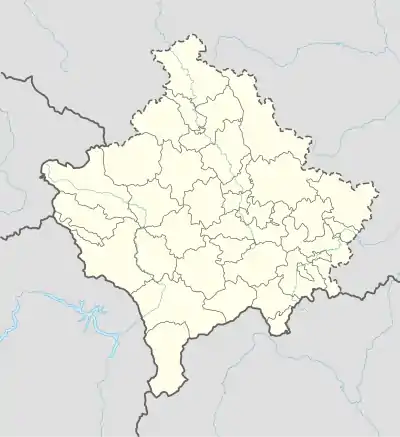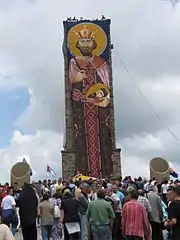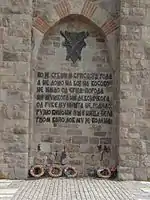Gazimestan
Gazimestan (Serbian Cyrillic: Газиместан, Serbian pronunciation: [ɡaziměstaːn]) is the name of a memorial site and monument commemorating the Battle of Kosovo (1389), situated about 6-7 kilometres southeast of the actual battlefield, known as the Kosovo field. The name is a portmanteau derived from Arabic ghazi, meaning "hero" or "champion", and Serbian word mesto, meaning "place". Gazimestan is reached from the Pristina–Mitrovica highway, on a 50-metre hill above the plain, ca. 5 km north-west from Pristina. Every year, on Vidovdan (St. Vitus Day), 28 June, a commemoration is held by the monument, which in later years is also covered by an image of Prince Lazar, who led the Serbian army at the battle.
| Газиместан | |
 Gazimestan monument | |
 Location in Kosovo | |
| Coordinates | 42°41′26″N 21°7′25″E |
|---|---|
| Location | 5 km (3.1 mi) from Pristina, Kosovo |
| Designer | Aleksandar Deroko |
| Type | memorial, tower |
| Material | stone |
| Height | 25 m (82 ft) |
| Completion date | 1953 |
| Dedicated to | fallen Serbian soldiers at the Battle of Kosovo (1389) |
History
The site was the place where Despot Stefan Lazarević erected a marble pillar with an inscription commemorating the battle.[1] That monument disappeared during the Ottoman period.[1] A monumental building in the form of a temple (Vidovdanski hram, "Vidovdan temple") designed by Croatian sculptor Ivan Meštrović was planned but never realized.[1] In 1924 a small monument honouring the Serbian heroes at the battle (Kosovski junaci, "Kosovo heroes") was erected; it was an obelisk with a cross on top.[1] It had a Cyrillic inscription: "To the fallen heroes for the honorable cross, freedom, and rights of their people – 1389 1912 – [by] thankful descendants, citizens and soldiers of the city of Priština".[1] During World War II, just after the Yugoslav capitulation, the monument was mined by Albanian fascist troops and completely destroyed.[1] In the years prior to the war, a larger monument had been planned and a cornerstone placed near where the present monument is, but the threat of war put it on hold.[2]
Until the end of World War I and the creation of Yugoslavia (1918) there were no conditions or opportunities for large masses to gather at the site. More notable celebrations of Vidovdan (St. Vitus' day) at Gazimestan are noticed only since 1919, in 1924 when the obelisk was erected, and finally before the start of the war, five and a half centuries after the battle.[2] In this period an estimated 20,000–100,000 people gathered on Vidovdan at Gazimestan.[2] Participants included not only native Kosovo Serbs, but also others from distant regions, such as the Bay of Kotor, Dalmatia, Bosnia and Old Montenegro, and Skoplje, Zagreb, Belgrade and some places in Vojvodina.[2] The celebration programme included, from 9 or 10 o'clock, commemoration in liturgy at Gračanica, Samodreža and Gazimestan, speeches, discourses, and artillery fire.[3] In 1935 and 1939 there were also air show.[3]
In 1989, on the 600th anniversary, Serbian president Slobodan Milošević held the famous Gazimestan speech at the site.
In 1997 the site was declared a cultural heritage of Serbia.[4]
In 1999, in the aftermath of the Kosovo War (1998–99) the monumental area was mined.[4]
In 2007, a 14-day march from Belgrade to Gazimestan was organized by several patriotic organizations.[5]
In 2009, the commemoration brought the biggest crowd since 1999, with several thousand people.[6]
In 2010, the Kosovo Police was handed over the task of guarding the monument, which was criticised by the Serbian government.[7] In 2014, President Tomislav Nikolić held a speech at the monument.[8]
Monument
The Gazimestan monument was designed by Aleksandar Deroko, in the shape of a medieval tower, and built in 1953 under the authority of SFR Yugoslavia.
:Whoever is a Serb and of Serb birth
- And of Serb blood and heritage
- And comes not to the Battle of Kosovo,
- May he never have the progeny his heart desires!
- Neither son nor daughter
- May nothing grow that his hand sows!
- Neither dark wine nor white wheat
- And let him be cursed from all ages to all ages!
— Inscription on the monument of the "Kosovo curse" attributed to Prince Lazar.
This version first appeared in the 1845 folk songs collection of Vuk Karadžić.
 Vidovdan 2009
Vidovdan 2009 Vidovdan 2013
Vidovdan 2013
Annotations
| a. | ^ Kosovo is the subject of a territorial dispute between the Republic of Kosovo and the Republic of Serbia. The Republic of Kosovo unilaterally declared independence on 17 February 2008. Serbia continues to claim it as part of its own sovereign territory. The two governments began to normalise relations in 2013, as part of the 2013 Brussels Agreement. Kosovo is currently recognized as an independent state by 99 out of the 193 United Nations member states. In total, 113 UN member states recognized Kosovo at some point, of which 14 later withdrew their recognition. |
References
- Marković 1989, p. 128.
- Marković 1989, p. 129.
- Marković 1989, p. 130.
- "Gazimestan". Spomenici. Republic of Serbia.
- "Vreme 860 - Kosovo: Vidovdan 2007". Vreme.com. Retrieved 5 December 2015.
- "Serbs celebrate Vidovdan in Kosovo". B92.net. 28 June 2009. Retrieved 5 December 2015.
- "Kosovo police take over historic site of Gazimestan". BBC News. 18 March 2010. Retrieved 5 December 2015.
- "Nikolić's speech at Gazimestan interrupted". B92.net. 30 June 2014. Retrieved 5 December 2015.
Sources
- Marković, Dragan (1989). "SVEČANOSTI NA GAZIMESTANU O VIDOVDANU IZMEĐU DVA SVETSKA RATA" (PDF). Etnološke sveske. 10: 127–134.
